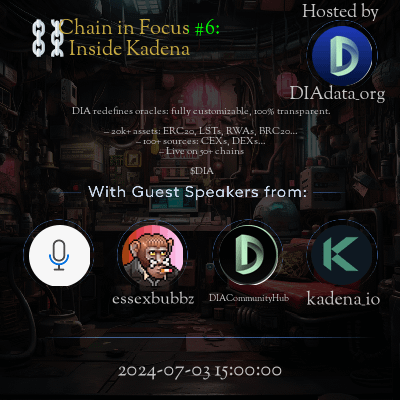This space is hosted by DIAdata_org
Space Summary
The Twitter space discussion delved into topics such as Proof of Work, decentralized ecosystems, and specific DeFi projects like Jupiter Exchange. Participants explored the challenges and opportunities within Proof of Work, discussed the importance of decentralization and security in blockchain ecosystems, and highlighted the potential of collateralizing real-world assets on the blockchain. The conversation also touched on the promises and obstacles of bringing assets on-chain, emphasizing Jupiter Exchange's role in the DeFi sector. Overall, the space showcased a positive sentiment towards collaboration, future developments, and the continuous evolution of the DeFi landscape.
Questions
Q: What was the focus of the discussion in the Twitter space?
A: The focus was on topics like Proof of Work, decentralized ecosystems, and DeFi projects such as Jupiter Exchange.
Q: What are the challenges and opportunities related to Proof of Work?
A: Challenges include energy consumption, while opportunities lie in its potential for security and validation in blockchain networks.
Q: Where do participants envision the end destination of assets being brought on-chain?
A: Participants envision heightened security, transparency, and efficiency for assets brought on-chain.
Q: What are the implications of locking liquidity in the ecosystem?
A: Locking liquidity can impact trading volume and yield farming strategies within the ecosystem.
Q: Which DeFi project was highlighted during the discussion?
A: Jupiter Exchange stood out as a notable DeFi project during the conversation.
Q: What is the significance of decentralized and secure ecosystems in blockchain?
A: Decentralized and secure ecosystems are crucial for building trust and fostering innovation in blockchain technology.
Q: How are real-world assets being incorporated into the blockchain realm?
A: Real-world assets are being tokenized and collateralized, allowing their representation on the blockchain.
Q: What promises and hurdles are associated with bringing assets on-chain?
A: Promises include increased accessibility and transparency, while hurdles involve regulatory challenges and user adoption.
Q: What is the general sentiment towards collaboration and future developments?
A: There is a positive outlook towards collaboration and anticipation for future innovations and advancements in the space.
Q: Any upcoming events or initiatives mentioned towards the end of the…
A: There were mentions of upcoming events and initiatives, signifying continued engagement and development in the field.
Highlights
Key Takeaways
- The conversation revolved around the potential and challenges of Proof of Work.
- Exploration of decentralization and security in blockchain ecosystems.
- Opportunities arising from collateralizing real-world assets on the blockchain.
- Discussion on promises and challenges of bringing assets on-chain.
- Highlighting Jupiter Exchange's significance in the DeFi sector.
Behind the Mic
Hello, everyone. Thanks for joining the Taraxa Monthly Development Update. Mihai has a brief update on some aspects that are basically mostly in the interest of the people that are developing on top of the APIs that we are currently offering. First thing, we're quite happy that we managed to join Forta. Congratulations to our Forta integration team and basically to all the people working on the APIs. The rank on Forta is actually quite nice. We rank among others in a very good place. There are some things that we need to work on, that we improve, like our latest security incident. We decided to take the tiger by the tail and we increased our security standards and procedures a lot. We are deploying on renewed procedures. These involve deployment on the development branch, deployment on the QA branch, deployment on the staging branch. The issue that we have is that basically most transactions were ranked by the time it takes for them to be included in blocks. That's not necessarily correct because actually most nodes receiving transactions propagate them further. Their ranking systems should take into account also this propagation metric. So we're still working on it. Our newly integrated DevOps team is really working on this. Okay, this is mostly from my side. Mihai, if you're ready, please take over. Thank you. Okay, thanks a lot, Eugene. Hi, everyone. For those of you who don’t know me, my name is Mihai. I’m a researcher at Taraxa, and I'm also the project manager for the Taraxa network. Yeah, thanks a lot for the update, Eugene. I'll continue a bit with this basically the development part, and for those of you who are not aware, we have two main aspects of our development. The mainnet is currently up and running. It has been since March this year, and there are certain applications that are currently being developed. However, there is no functionality deployed on mainnet as of now. There are multiple ways for you to get involved with projects on Taraxa. So we have our Hackathon that we launched last year, and we have the grant program. By the way, bridge is on time. Hackathon's going great. We're moving to the judging phase. Aspen was activated last month. Everything going smoothly. It also caps the overall tariff supply to 12 billion, and it made staking yields a lot more fair. And please be on the lookout for Echo, our decentralized infrastructure for AI agents. So you're going to be hearing a lot more of that coming, all right? So thank you very much. And in the future, every second Tuesday of each month, we're going to be doing these verbal updates through spaces and submit your questions ahead of time so that we can get it covered. Thank you very much for listening on this April development update for Taraxa. Bye.







